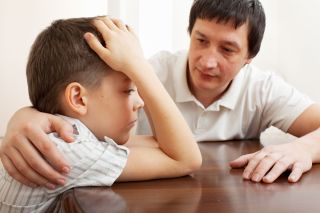Emotion Regulation
Helping Your Children Manage Their Emotions
How to practice skills related to emotional regulation with your child.
Updated July 10, 2023 Reviewed by Davia Sills
Key points
- Remind kids that some unpleasant situations are not about them (QTIP: quit taking it personally).
- The key is to help a child develop alternative explanations and benign motivations for others’ actions.
- Books, films, and TV can prompt conversations about how to interpret characters' actions.
- Within earshot of kids, discuss with friends various ways to interpret people’s actions.

I was recently asked by parents how they could help their son who struggles with managing a lot of big feelings. In parent-teacher conferences, his homeroom teacher had described how other instructors observe that he has difficulty tempering emotions on an almost daily basis and melts down with a higher frequency and intensity than other kids in the class. He gets upset at recess if he is not thrown the ball as often as he would like, and if he is not called on every time he raises his hand, he asserts that life is unfair. The list goes on, and this behavior is exhausting for both the child’s teachers and peers.
With two months until school starts up again, families have an opportunity to do some work with their children on skills with which they need support. For families whose children struggle with managing their emotions, building capacity in this area isn’t always easy, and it takes time. It’s not like you can sit down and teach the content of coping with difficult emotions and imagine that your child is going to integrate your lessons immediately and successfully. In fact, very few skills in the social-emotional domain can be taught this way. More often, what is needed is repeated and applied instruction.

Most important lessons are taught like this. If we think about teaching kids to remember to say “please” and “thank you,” it is learned because parents model this behavior and remind their kids to say these words hundreds if not thousands of times throughout their childhood. So, if your goal is to teach your children to deal more effectively with undesirable situations, you can model how to do it and weave discussion of it into your daily conversations with them.
See June’s post for an explanatory model, tips for parental modeling, and indirect coaching.
A key strategy is challenging the accuracy and validity of your children’s negative thoughts. Since negative thoughts tend to be distressing, the extent to which they can re-frame a situation more optimistically can determine the degree to which they can alter their emotional response to that situation. One approach is captured by the acronym QTIP: Quit taking it personally. Let your kids know that sometimes another person’s behavior is simply not about them. They still may not like someone’s words or actions, but at least they can entertain the possibility that the intention wasn’t to harm them.

You also may want to highlight this kind of skill or perspective when you are reading a story or watching a movie or television show with your children that depicts a character who either struggles with managing emotions or offers an example of managing them particularly well. Encourage your children to interpret the events by asking: Why do you think this character said or did that? If they interpret the character’s intentions negatively, you can ask: Have you ever done something like that? What might lead you to do that? Through these questions, you are trying to guide your children toward multiple ways of seeing any given situation, specifically toward interpretations that are less self-focused or that don’t assume the intentional meanness of another person. The questions you ask can also help build empathy in your children, which will make them better at reading others’ cues and may result in better peer exchanges and outcomes.

If the story you are reading or watching together portrays an event that disappoints or upsets a character, you can also help your children be less catastrophic in their interpretations by asking them something like, How much do you think “X” will matter in 10 minutes, 10 days, or 10 months? This question can help them re-evaluate the impact of any undesirable event.
Because a story’s resolution often naturally reaches a conclusion through which the character eventually recovers or is happier, you can highlight how this person coped with adversity or realized they could tolerate a degree of unpleasantness. By using the story as a springboard for having a conversation with your children, it will seem less like you are sitting them down for a lesson.

Another subtle way of coaching children’s capacity for reflection is to have conversations about a story or a movie with someone else but within earshot of your child—either in person or over the phone. If you are talking with colleagues or friends, you can ask, Why do you think that character did that? And you can add how a new interpretation totally changes how you feel about the situation: Now that I realize he might have done that because he felt insecure, it totally changes how I think about what he did. I never considered that he lacked self-confidence. He seemed so capable to me. In this way, you are modeling the habit of being reflective and willing to entertain other perspectives—rather than always being certain or assuming someone else’s negative intent.

I am providing you with simple, straightforward questions because it is important to have uncomplicated go-to’s that you can use repeatedly. You can change the language of these questions to fit your communication style, but their essence should remain. Over time, you will be able to exchange observations of multiple situations involving your children and yourself, as well as situations you both witness.
Pay attention to how your children’s feelings and responses change when they alter their perspectives of these situations. Of course, considering alternative explanations doesn’t always mean your children should embrace a situation they didn’t anticipate or want, but remind them that, in the end, they can survive it, and because of this, they are better equipped to take risks that can help them get closer to realizing some of their goals.
For parents of elementary-aged children, here are some books that might help you begin conversations like the ones I have mentioned in this blog post:
- Kindergarten and first grade
- Harry Versus the First 100 Days of School by Emily Jenkins
- Alexander and the Terrible, Horrible, No Good, Very Bad Day by Judith Viorst (appropriate through age 7/8)
Second and third grades (these are picture books, with the exception of Renée Watson’s Ways to Make Sunshine)
- Saturday by Oge Mora
- After the Fall by Dan Santat
- Surely Surely Marisol Rainey by Erin Entrada Kelly
- Ways to Make Sunshine by Renée Watson (This is a longer novel)
Fourth grade
- Grandfather Gandhi by Arun Gandhi
- Power Forward by Hena Khan




